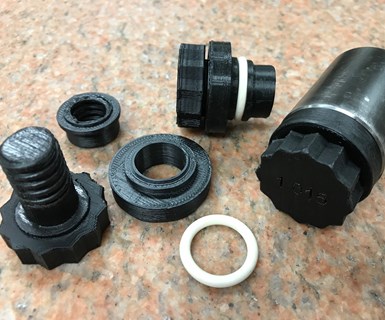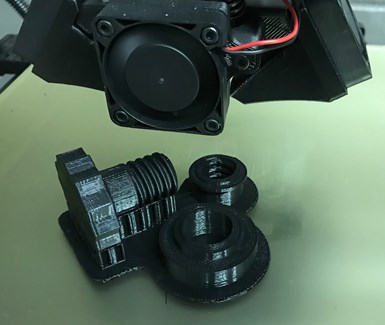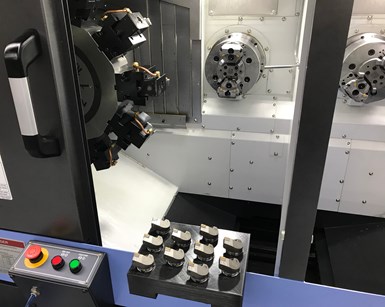3D Printing’s Value in a Production Turning Environment
A shop had a problem with chips and coolant being shot back through tube material it was machining on a bar-fed CNC turning center. Its solution was to 3D-print a plug to insert into the back end of the tubes. It uses its 3D printer in other ways, too.

3D-printed plugs install in the end of DOM tubing to prevent coolant and chips from shooting back through into a barfeeder attached to a CNC turning center.
Superior Metal Products in Omaha, Nebraska, has designed a unique plug it 3D-prints to prevent chips and coolant from shooting back through the tube and into the bar feeder while turning DOM tubing. “We struggled to find a solution that offered push-point consistency for the bar feeder and positive sealing for the various tube IDs we run,” explains Frank O’Connor, company president. “Tapered plugs tend to dislodge and leak, and care must be taken to ensure the plug end is perpendicular to the tube. Otherwise, push rod droop or tube orientation can cause push length variation.”

The three components were designed using CAD software, and it’s easy to modify the size to match any tube ID. The shop prints the plug size in the face of the knob.

The three main plug components are printed at the same time.
The plug features a 3D-printed ABS threaded knob, expander and nut (all are printed at the same time), as well as an appropriately sized O-ring. Once inserted into the end of a bar and tightened, it provides an effective seal and consistent push point that is perpendicular to the tube. The shop has a base plug design and simply modifies the sealing diameters depending on the tube ID and prints. It’s not a problem if a plug gets lost. 3D printing replacements is not costly.

The shop uses quick-change toolholder system for fast tool changes on its twin-spindle turning centers and 3D-prints trays to hold fresh tools for the 10-station-turret machines.
The shop also uses its 3D printer, a Lulzbot TAZ-6 desktop model, to create toolholder trays and other items to support its 5S workplace organization efforts. For example, hanging on the fence of a robot-tended machining cell for pump components are printed items to hold Allen wrenches, a broom, a dust pan, a cleaning bottle, a grease gun, job travelers and so on. The shop also prints job-specific trays for gages and other devices.
Related Content
-
Does a Scanning Probe Make Sense on a Swiss-Type?
Swiss-types have limited tooling capacity, but there can be advantages to giving up some of that capacity to take advantage of a touch probe — in fact, a scanning probe — to enable in-process part measurements.
-
Choosing the Right Machine for Turned and Milled Medical Parts
The medical market is known for exceptionally tight tolerances and difficult materials, which means that selecting the proper machine is necessary to ensure a job is profitable.
-
When a CNC Turn-Mill Doesn’t Turn
A shop in Big Sky Country uses a B-axis multitasking machine to produce complex, prismatic medical parts that require no turning complete from barstock.








.jpg;maxWidth=300;quality=90)




